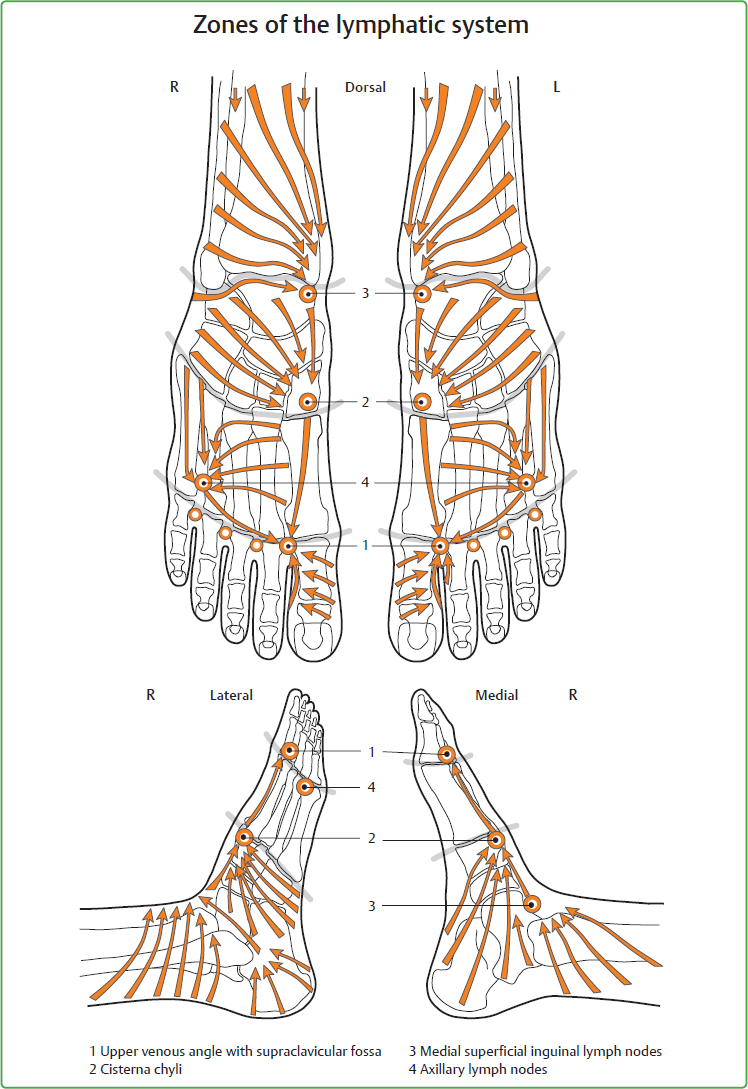29 Zones of the Lymphatic System Just as it is not possible to learn an instrument by reading about it, learning about the specific therapy for the zones of the lymphatic system cannot be done simply by reading either. To really be able to work with this therapy, “head” knowledge must be transformed into practical, “hand” knowledge by means of practical training and experience. In my opinion, the emergence of the specific zones of the lymphatic system nowadays is one of the principal developments in reflexotherapy of the feet (RTF). Experience of previous decades had shown that increasingly we could rely on the feet as a “self-image of the whole person,” making extraordinarily precise treatment possible. Thus, it was only logical for me to also start trying to assign the flow system of the lymphatics to the corresponding areas on the feet as early as the mid-1980s. After a few years of personal experience, and observation of the effects in corresponding groups of patients, in 1993 the zones of the lymphatic system were officially included at all our training centers. Admittedly, a few lymphatic zones had already been identified by W. FitzGerald and E. Ingham: the tonsils, appendix, spleen, and lymphatic areas of the inguinal region. But it was evident that the selective treatment technique developed hitherto would have to be changed in order to do justice to the principle of the lymphatic system in its entirety. Thus, a new treatment technique withgentle, targeted stroking movements guided by the physiological direction of flow of the lymph was developed. Of interest: When it is considered that all the organs apart from the brain are supplied with lymphatic vessels, it is understandable that even before comprehensive lymphatic treatment we also achieved good results with traditional RTF, above all, in patients with general lymphatic disorders. Nonetheless, it has been demonstrated that the results with the new way of treating the lymphatic system selectively have been significantly improved for specific lymphatic indications. • It is not painful. Nowadays, an increasing number of patients come for treatment who, for a variety of reasons, are unable to tolerate pain any more. They discover with relief how the gentle, stroking quality of RTF lymphatic treatment can set stagnating processes in motion again. • It has a significant impact on an emotional level. Although initially the positive effects were more evident on the physical level, it soon became clear that patients were also more stable emotionally. (Tip: another word for fluid is solution. As lymph is also a fluid, the double meaning of the word “solutions” confirms our decades of experience.) • It can be combined with manual lymphatic drainage, both during treatment and on an alternating basis during a course of treatment. • It is economical in terms of time because the treatment is concentrated on the small surface area of the feet. The following are indicated: • Lymphatic diseases of all kinds, also postoperatively • Chronic infections of the sinus cavities and ears • Allergies, in particular, in children, general lowered resistance • All skeletomuscular afflictions, restricted movement of the joints (apart from in the acute stage of inflammation) • Sports injuries of various kinds, accident after-care • Insufficiencies in the transport of various body fluids, for example, congested veins, circulatory disorders, reduced diuresis, premenstrual syndrome, lactation difficulties in nursing mothers, etc. • Chronic diseases such as multiple sclerosis, Parkinson’s disease, apoplexy
29.1 General Information
29.2 Advantages of RTF Lymphatic Treatment
29.3 Indications and Contraindications
Stay updated, free articles. Join our Telegram channel

Full access? Get Clinical Tree







